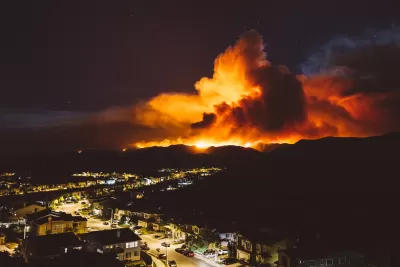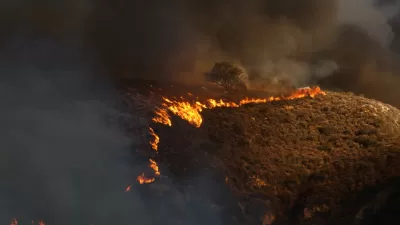More intense and widespread fires caused by climate change and changing air temperature are threatening more existing communities.

In an article for Source NM, Mojtaba Sadegh describes the worsening exposure of Americans to wildfire smoke. In the last two decades, close to 600,000 people were directly exposed to wildfires within 3 miles of their homes.
“Three-quarters of that 125% increase in exposure was due to fires’ increasingly encroaching on existing communities. The total burned area increased only 38%, but the locations of intense fires near towns and cities put lives at risk.” According to Sadegh, “Those statistics reflect how the number of people directly exposed to wildfires more than doubled from 2000 to 2019, my team’s new research shows.”
The analysis found 80 percent of wildfire exposure was, unsurprisingly, in the western states, with 70 percent of Americans exposed to wildfire hazards in California, despite the state only having 15 percent of burned areas.
The team found that, while development in the wildland-urban interface and unchecked growth is part of the problem, it only accounts for a small part of the increase in wildfire exposure. “Instead, three-quarters of this trend was driven by intense fires growing out of control and encroaching on existing communities.”
As the warming trend continues, wildfires will grow more intense and dangerous to existing communities. “Reducing emissions will help slow warming, but the risk is already high. Communities will have to both adapt to more wildfires and take steps to mitigate their impacts.”
FULL STORY: Human exposure to wildfires has more than doubled in two decades

Alabama: Trump Terminates Settlements for Black Communities Harmed By Raw Sewage
Trump deemed the landmark civil rights agreement “illegal DEI and environmental justice policy.”

Planetizen Federal Action Tracker
A weekly monitor of how Trump’s orders and actions are impacting planners and planning in America.

Why Should We Subsidize Public Transportation?
Many public transit agencies face financial stress due to rising costs, declining fare revenue, and declining subsidies. Transit advocates must provide a strong business case for increasing public transit funding.

Understanding Road Diets
An explainer from Momentum highlights the advantages of reducing vehicle lanes in favor of more bike, transit, and pedestrian infrastructure.

New California Law Regulates Warehouse Pollution
A new law tightens building and emissions regulations for large distribution warehouses to mitigate air pollution and traffic in surrounding communities.

Phoenix Announces Opening Date for Light Rail Extension
The South Central extension will connect South Phoenix to downtown and other major hubs starting on June 7.
Urban Design for Planners 1: Software Tools
This six-course series explores essential urban design concepts using open source software and equips planners with the tools they need to participate fully in the urban design process.
Planning for Universal Design
Learn the tools for implementing Universal Design in planning regulations.
Caltrans
Smith Gee Studio
Institute for Housing and Urban Development Studies (IHS)
City of Grandview
Harvard GSD Executive Education
Toledo-Lucas County Plan Commissions
Salt Lake City
NYU Wagner Graduate School of Public Service





























